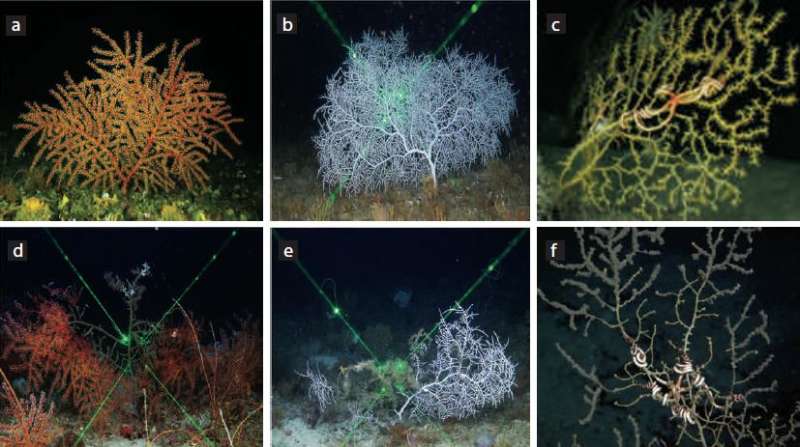Unlocking the mysteries of deepwater corals to restore the Gulf of Mexico

Coral genetics could save the Gulf of Mexico - though it may take a few hundred years.
The Gulf, bordered to the north by Alabama, Florida, Louisiana, Mississippi and Texas, was badly damaged by the 2010 Deepwater Horizon accident which resulted in the deaths of 11 oil rig workers and the largest marine oil spill in history.
The spill had a catastrophic impact on the Gulf's vast, interconnected ecosystems. It harmed natural resources as diverse as fish and shellfish, productive wetland habitats, sand beaches, birds, endangered and threatened sea turtles, protected marine mammals—and deepwater coral communities.
Deepwater corals—living deeper than 150 feet—are marine invertebrates, a group of animals without a backbone. Their branch-like structures serve as the foundation of many ecosystems in the Gulf, providing habitats for diverse and abundant fish communities to thrive and reproduce. Ensuring the restoration and sustainability of the Gulf's deepwater corals is key to ensuring the restoration and sustainability of the Gulf.
However, little is understood about how the Gulf's spatially discrete, island-like coral communities are connected to each other. Understanding the relationship between the communities is important for determining their reproductive patterns and, ultimately, for achieving their full regeneration.
That's where coral genetics comes in, according to Santiago Herrera, Visiting Assistant Professor in the Department of Biological Sciences at Lehigh University. Herrera is a Biological Oceanographer with expertise in molecular ecology, evolution and genomics of invertebrates, with a focus on deepwater corals.
He and his colleagues have been awarded a $1.3 million grant by the National Oceanic and Atmospheric Administration (NOAA) RESTORE Act Science Program, a science-based federal agency, to address crucial gaps in the understanding of the processes that shape population connectivity patterns in habitat-forming deepwater corals living between 150 and 7,500 feet deep in the Gulf of Mexico, including species directly impacted by the Deepwater Horizon oil spill.
In addition to Herrera - who will serve as lead - Principal Investigators are Andrea Quattrini from Harvey Mudd College; Annalisa Bracco of Georgia Institute of Technology and Peter Etnoyer of the National Centers for Coastal Ocean Science, a group within NOAA.
The team will collaborate with Erik Cordes of Temple University, as well as managers at the Flower Garden Banks National Marine Sanctuary, a federally designated and protected underwater area—the only one of its kind in the Gulf. The sanctuary has proposed an expansion of the boundaries of current protected areas to encompass additional coral sites. The team's work aims to help guide decisions about which sites are particularly important to designate as Marine Protected Areas and inform their management.
The grant will fund three expeditions to the Gulf for field sampling and data collection utilizing remotely operated vehicles. The first expedition begins next week on Wednesday, July 19th. The team will seek to determine the diversity and genetic structure of key coral populations. They will also identify the direction and rate of genetic exchange among coral populations to establish which ones are the source of the most successful larvae—the coral's "seeds" that eventually form new colonies.
Using a state-of-the-art population genomic analysis approach called Restriction-site Associated DNA Sequencing (RADseq)—pioneered by Herrera for use in corals—and predictive models of larval dispersal they will be able to estimate how far particular coral "families" spread and determine connectivity patterns among coral populations.
"We currently have a poor understanding of the factors that limit reproductive exchange among populations in deepwater corals as no studies have been performed to investigate the genetic connectivity patterns of coral communities at these depths between 150 and 450 feet, and deeper than 3,000 feet," says Herrera. "Gaining an holistic understanding of deepwater currents and larval dispersal patterns is critical to knowing which areas are the most crucial to protect to restore the Gulf."
Determining reproductive exchange among corals
When it comes to reproduction, corals have a lot in common with trees—both remain in place, relying on external mechanism to disperse their "seeds" to other locations. Trees' seeds are carried by animals or by the wind to locations on land where they germinate and take root. Deepwater corals depend on ocean currents to disperse their offspring, in the form of larvae.
One of the ways that Herrera and his colleagues will determine how the coral populations of the Gulf are connected is by looking at the interaction of species-specific traits among coral communities at different locations.
They will generate population genomic data using RADseq, a genomic sequencing strategy that can survey the genetic diversity contained in thousands of different loci (the position on a chromosome), making it ideal to infer dispersal rates and directionality of gene flow in populations. Using this method—which Herrera has already successfully used to elucidate patterns of genetic structure in corals—should dramatically improve the ability to detect underlying ecological and evolutionary patterns compared to previous studies.
"When we combine information about ocean currents with the genetic data, we will be able to infer how different coral populations in the Gulf are related," says Herrera. "These data will give us a window into how genes are being shared - whether, for example, a given coral population is mostly reproducing among itself or with other coral populations. Knowing this could reveal which coral populations are the sources of the most successful larvae."
He adds: "Because regeneration is likely to take decades or, even, centuries, due to corals' slow-growth rates, knowing which populations are the source of the most successful offspring is crucial information. Such data could inform decisions about which areas are the most important to protect for the regeneration of damaged corals and the ultimate restoration of the Gulf."
Provided by Lehigh University




















